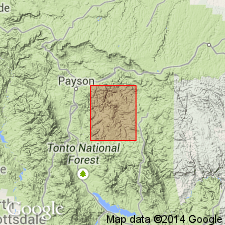
- Usage in publication:
-
- Flying W formation
- Modifications:
-
- Original reference
- Dominant lithology:
-
- Volcanics
- Conglomerate
- AAPG geologic province:
-
- Basin-and-Range province
Summary:
Pg. 1498 (table 1), 1500-1501, pl. 1. Flying W formation. Volcanic members of formation are: green, amygdaloidal basaltic pillow lavas containing sparse iron ore; a 150-foot-thick black, porphyritic keratophyre which extends 3.5 miles from Colcord to Houden Mesa; and a conglomerate composed of well-rounded gravel, cobbles, and boulders of volcanic rock. Thickness 375-3,200 feet. Unconformably underlies Houden formation (new); overlies Alder formation on south slope of Colcord Mesa with gradational contact, but elsewhere basal member of Flying W formation is either a conformable cobble conglomerate or a pillow lava. Age is Precambrian.
Type section: on lowest tributary to Walnut Creek; base of section approx. 4,450 feet elevation 1 mi north-northwest of Flying W ranch house, east-central AZ. Good exposures also occur west of Spring Creek 0.75 mi northwest of ranch house. Named from Flying W Ranch on Spring Creek, 12 mi west of Young, AZ, Diamond Butte quadrangle.
Source: US geologic names lexicon (USGS Bull. 1200, p. 1381).
For more information, please contact Nancy Stamm, Geologic Names Committee Secretary.
Asterisk (*) indicates published by U.S. Geological Survey authors.
"No current usage" (†) implies that a name has been abandoned or has fallen into disuse. Former usage and, if known, replacement name given in parentheses ( ).
Slash (/) indicates name conflicts with nomenclatural guidelines (CSN, 1933; ACSN, 1961, 1970; NACSN, 1983, 2005, 2021). May be explained within brackets ([ ]).

